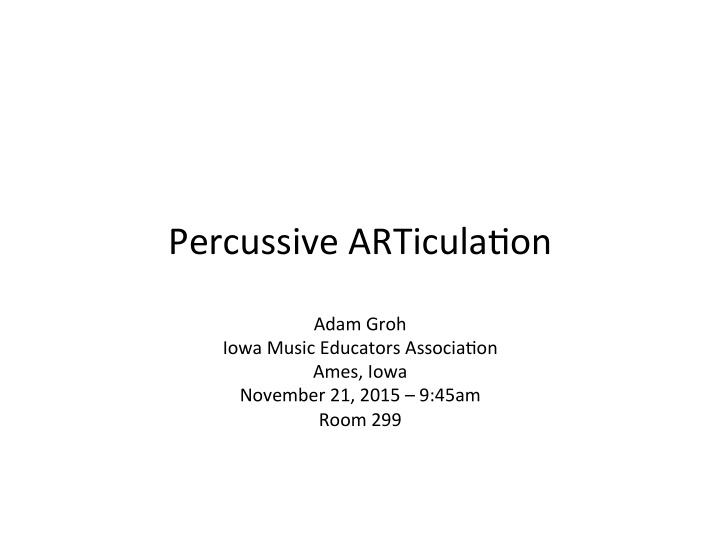



Percussive ¡ARTicula/on ¡ Adam ¡Groh ¡ Iowa ¡Music ¡Educators ¡Associa/on ¡ Ames, ¡Iowa ¡ November ¡21, ¡2015 ¡– ¡9:45am ¡ Room ¡299 ¡
A ¡story… ¡
“Being ¡an ¡‘ist’ ¡is ¡special. ¡ ¡If ¡you’re ¡an ¡‘ist’ ¡you’re ¡ a ¡pianist ¡or ¡a ¡violist, ¡and ¡like ¡all ¡‘ists’ ¡your ¡force ¡ of ¡defini/on ¡comes ¡from ¡something ¡central, ¡ something ¡commonly ¡held. ¡ ¡In ¡the ¡case ¡of ¡ musical ¡instruments, ¡it ¡comes ¡from ¡the ¡object ¡ itself ¡that’s ¡played.” ¡ ¡ ¡ ¡ ¡ ¡ ¡ ¡ ¡ ¡ ¡ ¡ ¡ ¡ ¡ ¡ ¡ ¡ ¡ ¡ ¡ ¡– ¡Steven ¡Schick ¡
What ¡are ¡we ¡aspiring ¡to ¡be? ¡ ¡ A ¡Drummer? ¡ ¡ A ¡Percussionist? ¡ ¡ A ¡Musician? ¡
Why ¡do ¡this ¡clinic? ¡ ¡ My ¡students ¡ ¡ My ¡educa/onal ¡experience ¡ ¡ Working ¡with ¡future ¡Music ¡Educators ¡
What ¡is ¡ar/cula/on? ¡
Ar/cula/on: ¡ “Direc/ons ¡to ¡a ¡performer ¡typically ¡through ¡ symbols ¡and ¡icons ¡on ¡a ¡musical ¡score ¡that ¡ indicate ¡characteris/cs ¡of ¡the ¡aYack, ¡dura/on, ¡ and ¡decay ¡of ¡a ¡given ¡note.” ¡ ¡
What ¡Percussionists ¡See ¡ Louder ¡ ¡ ¡ Really ¡Loud ¡or ¡Rimshot ¡(or ¡both) ¡ ¡ ¡ Half ¡Accent? ¡ ¡ ¡ Dead ¡stroke? ¡ ¡Typo? ¡ ¡Smudge ¡from ¡lunch? ¡ ¡ ¡ Uhh… ¡ ¡ ¡ C, ¡D, ¡E, ¡C… ¡ ¡Right? ¡
Common ¡Ar/cula/on ¡Markings ¡ Accent ¡ ¡ A ¡stress ¡or ¡special ¡emphasis ¡of ¡a ¡beat ¡ ¡ to ¡mark ¡its ¡posi/on ¡in ¡a ¡measure ¡ ¡ ¡ Marcato ¡ A ¡strongly ¡accented ¡note, ¡usually ¡with ¡ ¡ slight ¡separa/on ¡ ¡ ¡ Tenuto ¡ Perform ¡this ¡note/chord ¡for ¡its ¡full ¡ ¡ rhythmic ¡value ¡(or ¡longer) ¡ ¡ ¡ Staccato ¡ Detached, ¡separated, ¡and ¡dis/nct ¡ ¡ ¡ ¡ ¡ Stacca/ssimo ¡ Detached ¡and ¡short, ¡even ¡more ¡ ¡ extreme ¡than ¡staccato ¡ ¡ ¡ Slur ¡ All ¡notes ¡are ¡smoothly ¡connected ¡and ¡ grouped ¡together ¡as ¡a ¡unit/phrase ¡
Now ¡what? ¡
How ¡do ¡percussionists ¡change ¡their ¡sound? ¡ ¡
Try ¡a ¡different ¡mallet? ¡ Wrong. ¡ ¡ ¡ ¡ ¡ Well… ¡maybe ¡not, ¡but ¡we’ll ¡come ¡back ¡to ¡that. ¡
“Percussion ¡is ¡not ¡a ¡mechanical ¡art ¡form, ¡in ¡fact ¡ it’s ¡a ¡very ¡malleable ¡art ¡form. ¡ ¡In ¡fact, ¡the ¡least ¡ important ¡thing ¡we ¡do ¡is ¡to ¡hit ¡things. ¡ ¡The ¡most ¡ important ¡thing ¡we ¡do ¡is ¡to ¡raise ¡the ¡s/ck. ¡ ¡ That’s ¡where ¡the ¡art ¡is... ¡ ¡The ¡art ¡is ¡in ¡raising ¡it, ¡ and ¡poising ¡it ¡just ¡so ¡that ¡a ¡certain ¡kind ¡of ¡ lowering ¡is ¡instan/ated.” ¡ ¡ ¡ ¡ ¡ ¡ ¡ ¡ ¡-‑ ¡Steven ¡Schick ¡ ¡
“You ¡sound ¡how ¡you ¡look.” ¡ ¡ The ¡“6 ¡M’s” ¡ “Make ¡a ¡Musical ¡Mo/on ¡that ¡Matches ¡the ¡Musical ¡Moment.” ¡
Variables ¡ S/cking ¡Choices ¡ Stroke ¡ – Speed ¡ – Height ¡ – Follow-‑through ¡ Grip ¡Pressure ¡ Implement ¡Selec/on ¡
S/cking ¡Considera/ons ¡ Common ¡s/cking ¡systems ¡ – Straight ¡ – Pure ¡Alterna/ng ¡ Other ¡op/ons ¡ – Doubles, ¡Triples, ¡combina/ons ¡ Func/onal ¡vs. ¡ar/s/c ¡s/ckings ¡ – Focus ¡on ¡what’s ¡above ¡the ¡staff ¡not ¡underneath ¡ – S/ckings ¡are ¡like ¡string ¡bowings, ¡alternate ¡ fingerings ¡for ¡wind ¡players, ¡and ¡pianists ¡fingerings ¡
Peters ¡– ¡ Advanced ¡Snare ¡Drum ¡Studies ¡ ¡ “Etude ¡No. ¡2” ¡
Stroke ¡ The ¡good ¡and ¡bad ¡of ¡“piston” ¡stroke. ¡ Speed ¡ – Faster ¡= ¡brighter, ¡more ¡ar/cula/on ¡ Height ¡ – Protect ¡your ¡sound ¡ – Protect ¡your ¡instrument ¡ Follow-‑through ¡ – Stay ¡connected ¡to ¡the ¡notes ¡like ¡a ¡pianist ¡
Grip ¡ ¡ More ¡pressure ¡= ¡more ¡ar/cula/on ¡ ¡ Less ¡pressure ¡= ¡less ¡ar/cula/on ¡ ¡ Dial ¡it ¡up ¡or ¡down, ¡but ¡you ¡have ¡to ¡be ¡in ¡control. ¡
Table ¡of ¡Common ¡Stroke ¡Types ¡ Speed ¡ Physical ¡ Follow-‑through ¡ Grip ¡Pressure ¡ Characteris1cs ¡ Accent ¡ Moderate ¡ Wrist ¡Turn ¡ Moderate ¡ Moderate ¡ Legato/Slur ¡ Slow ¡ Relaxed ¡through ¡ Slow, ¡but ¡ Loose ¡ arm ¡and ¡wrist ¡ consistent ¡ movement ¡ Staccato ¡ Very ¡fast ¡ Wrist, ¡jabbing ¡ Very ¡fast ¡(piston ¡ Very ¡Firm ¡ mo/on, ¡upstroke ¡ stroke) ¡ Tenuto ¡ Slow ¡ More ¡weight ¡ Mallet ¡stays ¡ Firm, ¡with ¡subtle ¡ than ¡normal ¡ down ¡for ¡ squeeze ¡on ¡ stroke, ¡but ¡ dura/on ¡of ¡note ¡ impact ¡ minimize ¡aYack ¡ Marcato ¡ Moderate/Slow ¡ Heavy, ¡weighted ¡ Mallet ¡stays ¡ Firm, ¡but ¡relaxing ¡ stroke, ¡primarily ¡ down ¡ on ¡contact ¡ with ¡forearm ¡
Ar/cula/on ¡and ¡Stroke ¡Speed ¡
Ford ¡-‑ ¡ Manha3an ¡
Manha3an ¡2 ¡
Manha3an ¡ 3 ¡
Implements ¡ ¡ The ¡golden ¡rule. ¡ – Mass ¡= ¡Volume ¡ – Hardness ¡= ¡Ar/cula/on ¡ ¡ Choose ¡mallets ¡that ¡work ¡WITH ¡you. ¡ ¡ Some ¡instruments ¡are ¡more ¡affected ¡by ¡ implement ¡selec/on ¡than ¡others. ¡
So ¡what? ¡ (How ¡do ¡I ¡bring ¡this ¡into ¡my ¡curriculum?) ¡ ¡ Talk ¡the ¡talk. ¡ – Just ¡like ¡the ¡English ¡teacher ¡working ¡on ¡vocabulary. ¡ Incorporate ¡ar/cula/on ¡into ¡exercises, ¡warm-‑ups, ¡and ¡assigned ¡ etudes. ¡ – You ¡already ¡vary ¡tempo, ¡and ¡possibly ¡dynamics. ¡ ¡Why ¡not ¡ar/cula/on? ¡ Experiment ¡WITH ¡your ¡students. ¡ – If ¡you ¡have ¡an ¡idea, ¡try ¡it. ¡ Be ¡on ¡the ¡lookout ¡for ¡sounds ¡you ¡like. ¡ – Don’t ¡be ¡afraid ¡to ¡ask. ¡ Know ¡what’s ¡in ¡your ¡students’ ¡mallet ¡bags. ¡ – You ¡don’t ¡have ¡to ¡know ¡every ¡mallet ¡in ¡the ¡world. ¡ ¡Just ¡theirs. ¡
More recommend